字符动手动脑
2017-10-26 22:12 Robortxin 阅读(133) 评论(0) 编辑 收藏 举报动手动脑
- 请运行以下示例代码StringPool.java,查看其输出结果。如何解释这样的输出结果?从中你能总结出什么?
public class StringPool {
public static void main(String args[])
{
String s0="Hello";
String s1="Hello";
String s2="He"+"llo";
System.out.println(s0==s1);//true
System.out.println(s0==s2);//true
System.out.println(new String("Hello")==new String("Hello"));//false
}
}运行结果:
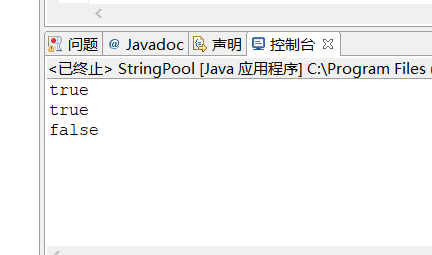
使用new关键字创建字符串对象时,内容相同的字串常量只保存一份以节约内存所以s0,s1,s2实际上引用的是同一个对象在一个内存空间内。
- 为什么会有下述的输出结果?从中你又能总结出什么?
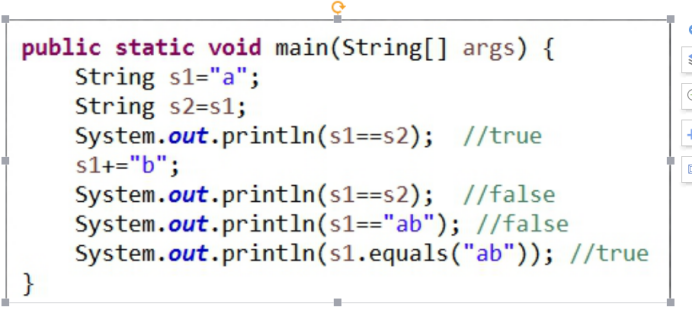
输出结果: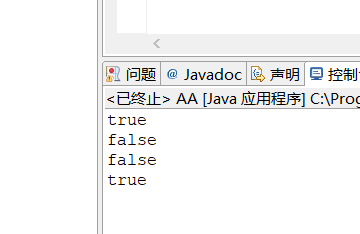
给字串变量赋值意味着:两个变量(s1,s2)现在引用同一个字符串对象“a”
String对象的内容是只读的,使用“+”修改s1变量的值,实际上是得到了一个新的字符串对象,其内容为“ab”,它与原先s1所引用的对象”a”无关,所以,s1==s2返回false;
代码中的“ab”字符串是一个常量,它所引用的字符串与s1所引用的“ab”对象无关。
- 请查看String.equals()方法的实现代码,注意学习其实现方法
public class StringEquals {
/**
* @param args the command line arguments
*/
public static void main(String[] args) {
String s1=new String("Hello");
String s2=new String("Hello");
System.out.println(s1==s2);
System.out.println(s1.equals(s2));
String s3="Hello";
String s4="Hello";
System.out.println(s3==s4);
System.out.println(s3.equals(s4));
}
}运行结果: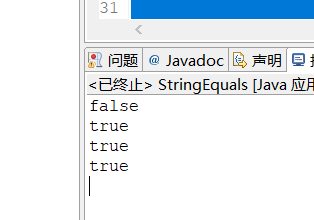
如果是同一个对象的引用,可知对象相等,返回true;如果不是同一个对象,equals方法挨个比较两个字符串对象内的字符,只有完全相等才返回true,否则返回false。
4.请阅读JDK中String类上述方法的源码,模仿其编程方式,编写一个MyCounter类,它的方法也支持上述的“级联”调用特性,其调用示例为:
MyCounter counter1=new MyCounter(1);
MyCounter counter2=counter1.increase(100).decrease(2).increase(3);
….
public class MyCounter
{
int i;
public MyCounter(int i)//构造方法
{
this.i=i;
}
public MyCounter()//空构造方法
{
}
public MyCounter increase(int d)
{
MyCounter a=new MyCounter();
a.i=i+d;
return a;
}
public MyCounter decrease(int d)// 实现data减的方法,并返回对象
{
MyCounter a=new MyCounter();
a.i=i-d;
return a;
}
public static void main(String[] args)
{
MyCounter counter1=new MyCounter(1);//创建对象counter1
MyCounter counter2=counter1.increase(100).decrease(2).increase(3);
System.out.println(counter2.i);
}
}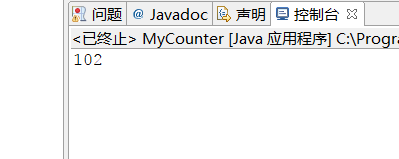
整理String类的Length()、charAt()、 getChars()、replace()、 toUpperCase()、 toLowerCase()、trim()、toCharArray()使用说明、阅读笔记
length() 返回字符串的长度
charAt () 例:char ch;ch="abc".charAt(1); 返回'b'搜索返回所指定的字符
getChars()void getChars(int sourceStart,int sourceEnd,char target[],int targetStart)sourceStart指定了子串开始字符的下标,sourceEnd指定了子串结束后的下一个字符的下标。因此, 子串包含从sourceStart到sourceEnd-1的字符。接收字符的数组由target指定,target中开始复制子串的下标值是targetStart。将字符从此字符串复制到目标字符数组
replace() (char aa ,char bb) 将aa用bb替代
toUpperCase() 将字符串内的字符改写成大写
toLowerCase()将字符串内的字符改写成小写
trim() String x=”ax c”;System.out.println(x.trim());/是去两边空格的方法
toCharArray()将字符串转换成字符数组




